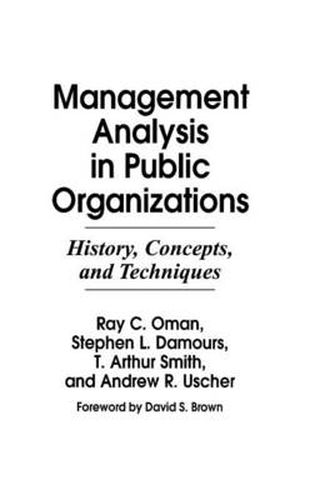Readings Newsletter
Become a Readings Member to make your shopping experience even easier.
Sign in or sign up for free!
You’re not far away from qualifying for FREE standard shipping within Australia
You’ve qualified for FREE standard shipping within Australia
The cart is loading…






As public organizations seek ways to provide better services and products at lower costs, they are turning more and more to management analysis (MA). This guide aims to help analysts, managers, and administrators understand how MA can improve output, productivity and bottom line performance. This volume explains the quantitative and qualitative approaches that management analysts employ in problem solving and enumerates MA’s contributions to improving organization’s decision making. It also makes clear that the relationship between the analyst and the administrator is a collaborative one, and that to achieve excellence each must understand the other’s methods of operation, viewpoints, and goals. The book opens with a discussion of MA theory and its many appplications, drawing on government regulations and the literature in the field as well as original research. The authors’ discussion of the history and development of MA, including current trends, seeks to help the reader understand the nature and direction of the field. The volume also treats the core areas of the practicing management analyst including automation, and productivity, as well as emerging specialities such as policy analysis, programme evaluation, and rigorous analytical studies. Because of the growing market for management analysis in private and public sectors, one chapter is devoted to MA services provided by private firms.
$9.00 standard shipping within Australia
FREE standard shipping within Australia for orders over $100.00
Express & International shipping calculated at checkout
As public organizations seek ways to provide better services and products at lower costs, they are turning more and more to management analysis (MA). This guide aims to help analysts, managers, and administrators understand how MA can improve output, productivity and bottom line performance. This volume explains the quantitative and qualitative approaches that management analysts employ in problem solving and enumerates MA’s contributions to improving organization’s decision making. It also makes clear that the relationship between the analyst and the administrator is a collaborative one, and that to achieve excellence each must understand the other’s methods of operation, viewpoints, and goals. The book opens with a discussion of MA theory and its many appplications, drawing on government regulations and the literature in the field as well as original research. The authors’ discussion of the history and development of MA, including current trends, seeks to help the reader understand the nature and direction of the field. The volume also treats the core areas of the practicing management analyst including automation, and productivity, as well as emerging specialities such as policy analysis, programme evaluation, and rigorous analytical studies. Because of the growing market for management analysis in private and public sectors, one chapter is devoted to MA services provided by private firms.